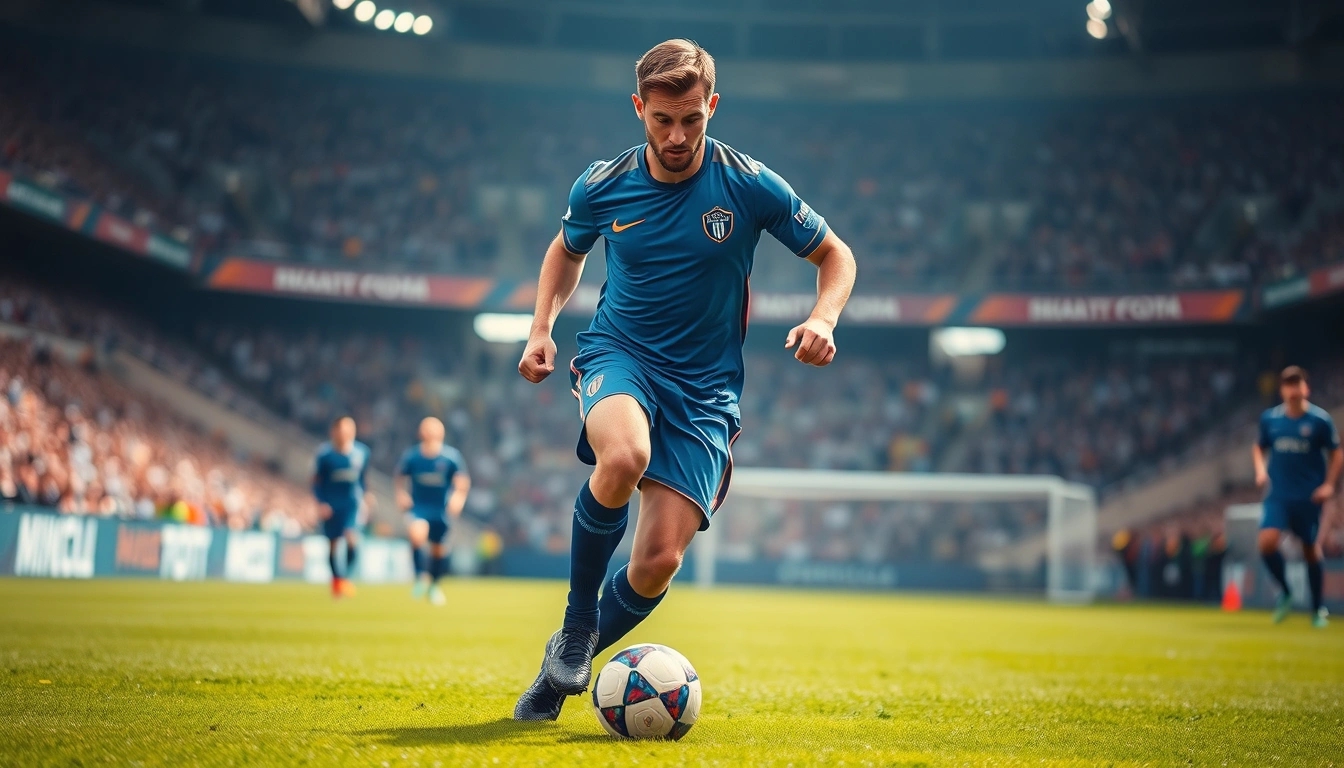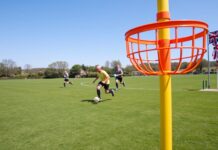Becoming a smarter midfielder isn’t just about running around like a headless chicken chasing the ball; it’s an art and a science rolled into one sweaty, muddy package. You gotta blend skill, vision, and a pinch of cunning strategy to truly boss the middle of the pitch. Midfielders are like the brain of the team, pulling strings and making things tick, but it’s not all glamour and glory. It’s about outsmarting opponents, controlling the game’s rhythm, and making split-second decisions that either make you a hero or the scapegoat.
Understanding the Role of a Midfielder
Let’s be honest, midfielders are the unsung heroes. They’re the engine room, the link between defense and attack, and often the player who carries the most responsibility. You’re not just running up and down; you’re reading the game, breaking up plays, and setting up your forwards to score. It’s a balancing act—defend when you need to, attack when you can, and always keep your head in the game.
| Midfielder Responsibilities | Key Skills Needed |
|---|---|
| Defensive Support | Tackling, Positioning |
| Playmaking | Vision, Passing Accuracy |
| Game Tempo Control | Decision Making, Stamina |
Developing Vision and Awareness
You gotta train your eyes and brain to work overtime. It’s not just about where the ball is, but where it’s going to be. Anticipate teammates’ runs, spot gaps in the defense, and always be thinking two steps ahead. This is where many midfielders fall flat—they get tunnel vision and miss the bigger picture. Try scanning the field regularly and practice “reading” the game during training.
- Keep your head up when receiving the ball
- Practice peripheral vision drills
- Watch professional games and analyze player movement
Mastering Ball Control and Passing
If your ball control is shaky, you might as well hand the ball to the other team. Precision passing is your best friend—razor-sharp and quick. This means working on your first touch, short passes, long balls, and even those cheeky through balls that split defenses. Under pressure? Stay calm and keep the ball glued to your feet.
Drill Example:1. Wall Passes – 50 reps each foot2. One-touch passing with a partner3. Dribbling through cones under time constraints
Improving Physical Fitness and Stamina
Look, midfielders cover the most ground—no argument there. You need endurance that doesn’t quit halfway through the second half and strength to hold your ground in tackles. But beware of overtraining; burning out is real. Mix cardio with strength training and don’t forget recovery days.
Reading the Game Like a Pro
This is where the mental game kicks in. Predicting what the opponent will do next isn’t magic—it’s experience, study, and sometimes just gut feeling. Adapt your tactics on the fly and keep your cool when the pressure’s sky-high. The best midfielders seem to have a sixth sense for chaos.
Communication and Leadership on the Pitch
Don’t underestimate the power of a loud voice and confident commands. Being vocal helps organize the team, especially when things get messy. Leadership isn’t just for captains; every midfielder should be a mini-coach on the field.
Analyzing Professional Midfielders
Want to get better? Watch the pros. Study their positioning, how they handle pressure, and their decision-making. Learn from their mistakes too—nobody’s perfect.
Common Mistakes and How to Avoid Them
- Overcommitting to tackles and leaving gaps behind
- Poor communication leading to confusion
- Neglecting physical conditioning
- Getting tunnel vision and missing open teammates
Training Drills and Exercises for Smarter Play
Practice makes perfect, but practice smart. Incorporate decision-making drills, small-sided games that force quick thinking, and technical exercises that simulate match pressure.
| Drill | Purpose |
|---|---|
| Rondo Circles | Quick passing, spatial awareness |
| Shadow Play | Positioning, movement without the ball |
| Pressure Dribbling | Ball control under pressure |
So, yeah, becoming a smarter midfielder isn’t a walk in the park. It’s a grind, a hustle, and a mental chess game all at once. But nail these aspects, and you’ll be the player every coach wants in the middle of the pitch.
Understanding the Role of a Midfielder
Midfielders, often dubbed the engine room of any football team, are the unsung heroes who keep the entire squad ticking. They’re the players who don’t just run around like headless chickens chasing the ball; no, they’re the ones who balance the chaotic dance between defense and attack. Think of them as the team’s conductors, orchestrating every move, every pass, and every tactical shift with a mix of finesse and grit. Without midfielders, a team is like a car without an engine — it just won’t go anywhere.
Now, why are midfielders so crucial? For starters, they dictate the tempo of the game. Ever noticed how some teams slow the game down to a crawl or speed it up to a frantic pace? That’s usually down to the midfield maestro deciding when to hold the ball or launch a quick break. They’re like chess players thinking several moves ahead, constantly scanning the pitch, positioning themselves to intercept passes or create chances. It’s a mental game as much as a physical one.
| Midfielder Responsibilities | Key Skills Needed |
|---|---|
| Linking defense and attack | Passing accuracy, ball control |
| Dictating game tempo | Vision, decision-making |
| Breaking up opposition plays | Tackling, positioning |
| Creating scoring opportunities | Creativity, awareness |
| Supporting defense | Stamina, discipline |
But here’s the kicker — midfielders must be versatile. One moment they’re defending like a wall, the next they’re threading a needle with a killer pass. It’s a constant juggling act. And don’t even get me started on the physical demands. These players cover more ground than anyone else, often running 10-12 kilometers per game. So, if you’re thinking of stepping into those boots, better be ready to sweat buckets.
- Decision-making: Knowing when to pass, dribble, or shoot can make or break a play.
- Positioning: Being in the right place at the right time is everything.
- Communication: Midfielders often act as the team’s eyes and ears, directing teammates.
It’s not all just running and passing though. The best midfielders possess an almost sixth sense about the game. They anticipate opponents’ moves, exploit tiny gaps in the defense, and keep cool under pressure. Sometimes it looks effortless, but trust me, it’s hours of practice and a deep understanding of the game.
In short, midfielders are the heart and soul of the team. They’re the bridge connecting defense and attack, the brain behind the team’s strategy, and the workhorse who never stops hustling. Without them, football would be a lot less exciting — and a lot messier too.
Quick Tips for Aspiring Midfielders:
- Always keep your head up; don’t just stare at the ball.- Work on both feet; being one-footed is so last century.- Build your stamina; you’ll need it for those relentless sprints.- Study the game; watch pros and learn from their positioning.
So next time you see a midfielder pulling the strings on the pitch, give them a nod of respect. They’re the ones making the magic happen behind the scenes.
Developing Vision and Awareness
Okay, so you want to be that midfielder who’s always two steps ahead, right? The one who spots a run before it happens, finds teammates in tight spots, and just seems to have eyes everywhere on the pitch. Well, that’s not magic — it’s about sharpening your field vision and situational awareness. But let’s be honest, it’s easier said than done. You don’t just wake up one day and suddenly see the game like a chess grandmaster. It takes practice, patience, and a bit of street-smart football sense.
First off, what exactly is vision in football? It’s not just about seeing the ball or the guy in front of you. It’s about perceiving the entire field — the spaces, the players’ movements, and the unfolding patterns. Think of it like this: your brain needs to process a dozen things at once, from a teammate’s subtle body language hinting at a run, to an opponent’s slight shift that signals a potential interception.
- Scan constantly: Don’t just stare at the ball. Make it a habit to lift your head and take in your surroundings every couple of seconds.
- Anticipate movement: Try to predict where your teammates and opponents will be, not where they are now.
- Use your peripheral vision: Train yourself to notice things happening just outside your direct line of sight.
Now, situational awareness is the big picture — knowing what’s going on around you, how the game’s tempo is shifting, and what your team needs at that very moment. Are you supposed to hold the ball, speed up the attack, or drop back to defend? This awareness often separates good players from great ones.
| Aspect | How to Develop It | Why It Matters |
|---|---|---|
| Field Vision | Practice scanning the field regularly; watch professional games and note player positioning. | Helps in spotting open teammates and exploiting gaps. |
| Situational Awareness | Play small-sided games; simulate pressure scenarios in training. | Improves decision-making under pressure and game control. |
| Peripheral Vision | Eye-tracking drills; focus on multiple objects at once. | Allows you to catch runs or threats outside your direct view. |
One practical tip? Watch the pros, but don’t get starstruck. Study how midfield maestros like Xavi or Busquets don’t just run around but almost feel the game. Notice how they don’t always chase the ball but instead position themselves to intercept or launch attacks. It’s like they have a sixth sense — and you can develop it too.
Here’s a little exercise to try: during your next training, force yourself to keep your head up while dribbling. Sounds simple, but it’s brutal at first. You’ll probably lose the ball a few times, but that’s the point. It trains your brain and feet to work independently — a key skill for any smart midfielder.
In the end, developing vision and awareness is less about flashy skills and more about mental sharpness. It’s about being present, thinking ahead, and staying curious about the game’s flow. So next time you’re out there, don’t just play — observe, anticipate, and outthink.
Quick Summary:
- Keep scanning the field; don’t tunnel vision on the ball.
- Train your peripheral vision with drills and real-game scenarios.
- Watch and learn from top midfielders’ positioning and decision-making.
- Practice with pressure; awareness grows when you’re forced to think fast.
Trust me, once you get this down, the game won’t just be about running and kicking — it’ll be a mental battle you’re winning every time. And that, my friend, is how you become a smarter midfielder.

Mastering Ball Control and Passing
Alright, let’s get real about one of the most underrated yet absolutely crucial skills for any midfielder: ball control and passing. It’s not just about kicking the ball here and there like you’re playing some casual Sunday match. No, sir! This is the bread and butter of a midfielder’s game—the kind of stuff that keeps the team ticking, the opposition guessing, and the crowd on their toes.
First off, ball control isn’t just about sticking the ball to your feet like it’s magnetized (though, wouldn’t that be neat?). It’s about being able to receive the ball cleanly under pressure, with defenders breathing down your neck, and then making the next move in a split second. Think of it as your personal handshake with the ball—smooth, confident, and reliable. If you fumble here, you’re handing the ball over on a silver platter. And you don’t want that.
- Why is tight ball control vital? It lets you keep possession even when the opposition is aggressive.
- How to practice? Simple drills like juggling, close-quarter dribbling, and receiving passes at different speeds.
- Pro tip: Use all parts of your foot—the sole, inside, outside—to master different touch types.
Now, onto passing—oh boy, this is where things get spicy. Passing isn’t just about sending the ball to a teammate; it’s about precision, timing, and vision. A good pass can slice through defenses like a hot knife through butter, while a sloppy one? Well, that’s an invitation for a counterattack and a facepalm moment.
| Passing Type | Description | When to Use |
|---|---|---|
| Short Pass | Quick, accurate passes for tight spaces | Maintaining possession and building play |
| Long Pass | Switching the field or launching attacks | Breaking defensive lines or exploiting space |
| Through Ball | Pass that splits defenders to find a teammate | Creating goal-scoring opportunities |
Here’s a bit of a reality check: mastering these passes isn’t about just kicking the ball hard or aiming blindly. It’s about reading your teammates’ runs, understanding the flow of the game, and making split-second decisions. And yeah, sometimes you’ll mess up. You’ll send a pass to no one or overhit it into the stands. But hey, that’s part of learning.
Practical advice? Practice with a partner or against a wall, focusing on both feet. Don’t just hammer the ball; work on finesse and placement. Challenge yourself with drills that simulate game pressure—like receiving the ball with a defender closing in. And always keep your head up. Vision is everything.
Drill Example:1. Set up cones 5 yards apart.2. Dribble through cones with close touches.3. Pass to a partner positioned 10 yards away.4. Partner returns the ball with one touch.5. Repeat with increasing speed.
To wrap it up, if you want to be the midfielder that everyone trusts to keep the ball moving and the game alive, focus on the details of your touch and the intelligence behind your passes. It’s not flashy, but it’s the kind of stuff that wins games.
Improving Physical Fitness and Stamina
Alright, let’s get real about midfielders — those tireless warriors who seem to have endless energy, running up and down the pitch like their legs are powered by some secret fuel. Why? Because endurance and strength aren’t just nice-to-haves; they’re absolute essentials. Midfielders cover more ground than any other position, juggling defense and attack like a circus pro, and if your stamina tanks halfway through, well, good luck keeping up. Trust me, it’s brutal out there.
Now, you might be thinking, “Just run more, right?” But hold your horses. It’s not about clocking endless miles on the treadmill until you collapse. Training smart beats training hard every time. The trick is balancing cardiovascular endurance with muscular strength, so you don’t just run forever but do it with power and control. Think of it like this: you want to be the marathon runner who can also sprint when needed, not the sprinter who’s out of breath after 10 minutes.
- Endurance training: Incorporate interval runs — short bursts of high intensity followed by recovery jogs. It mimics the stop-and-go nature of a match better than steady-state running.
- Strength training: Focus on compound movements like squats, lunges, and deadlifts. These build the leg and core power essential for those explosive tackles and quick turns.
- Recovery: Don’t skip it. Overtraining equals burnout. Stretch, hydrate, and get enough sleep. Your muscles will thank you.
| Training Type | Example Exercise | Purpose |
|---|---|---|
| Endurance | Interval Runs (e.g., 4 x 400m sprints with 2 min rest) | Build cardiovascular stamina and simulate match intensity |
| Strength | Weighted Squats (3 sets of 8 reps) | Enhance leg power for better speed and tackling |
| Recovery | Foam Rolling and Stretching | Prevent injuries and reduce muscle soreness |
Let’s be honest, the mental side of stamina is just as gnarly. You can be physically fit, but if your brain’s fried halfway through, you’re toast. Midfielders need to keep their heads clear, make smart decisions, and stay sharp — all while their legs are screaming for mercy. So, mixing in some mental endurance drills, like decision-making under fatigue, can give you an edge.
Here’s a quick tip: try pairing technical drills with short sprints. For example, dribble through cones after a 30-second sprint. It’s brutal but mimics real-game pressure where your brain and body are taxed simultaneously.
Bottom line? Improving physical fitness and stamina as a midfielder isn’t about grinding yourself into the ground. It’s about smart, targeted training that builds your body and mind to handle the relentless demands of the role. So, lace up, hit the gym, but don’t forget to listen to your body — because burning out fast is the quickest way to bench yourself.
Keep pushing, but keep it smart!
Reading the Game Like a Pro
Football’s mental battlefield is where games are won or lost, and if you think it’s all about fancy footwork and lightning speed, well, you’re missing half the story. Being a top-tier midfielder means predicting opponents’ moves, adjusting tactics on the fly, and most importantly, keeping your cool when the heat is on. Sounds simple? Ha! Not even close.
Imagine you’re in the thick of the match, the score’s tight, the crowd’s roaring, and your opponent’s eyeing your every move like a hawk. The key? Anticipation. This isn’t some magic trick; it’s about reading body language, spotting patterns, and knowing your rival’s tendencies. For example, does that winger always cut inside on his right foot? Does your opposing midfielder favor short passes under pressure? These little clues add up, giving you the edge to intercept, block, or launch a counterattack.
| Signs to Watch | What It Means | How to React |
|---|---|---|
| Opponent’s eyes looking to the flank | Likely pass or cross coming | Shift defensive position to block |
| Player pauses before dribbling | Considering a feint or change of direction | Stay balanced, don’t commit too early |
| Teammate gestures urgently | Spotting an open space or threat | Adjust position quickly to support |
Now, mid-match tactical tweaks? That’s where many players freeze. But the pros? They’re like chess grandmasters, constantly reassessing the board. Maybe the opposing team is pressing high, so you drop deeper to help the defense. Or perhaps they’re tiring, so you push forward aggressively. It’s about fluid thinking, not rigid plans.
- Stay alert: Watch how the game’s tempo shifts.
- Communicate: Your teammates need to hear your observations.
- Be flexible: Don’t cling to the original game plan if it’s failing.
Pressure? Oh, the pressure! When the clock’s ticking down and every mistake feels like a disaster waiting to happen, that’s when mental toughness counts. The trick is to breathe, focus on what you can control, and not let nerves take over. Easier said than done, right? But with practice, you can build that steel-trap mindset.
Tips for Staying Cool Under Pressure:- Take deep, controlled breaths to calm your heart rate.- Visualize successful plays before they happen.- Break the game into small moments; focus on the next pass, not the final whistle.- Trust your training and instincts.
In the end, reading the game like a pro isn’t just about smarts; it’s about emotional intelligence, sharp instincts, and a pinch of guts. So next time you’re on the pitch, don’t just play the ball—play the mind behind it.

Communication and Leadership on the Pitch
Let’s be honest, football isn’t just about fancy footwork or banging in goals — it’s a chaotic dance where communication and leadership often spell the difference between a team that clicks and one that falls apart like a house of cards. You can have all the skill in the world, but if no one’s talking, shouting, or at least gesturing like mad, chaos will reign supreme. It’s the midfielder’s job to be the vocal backbone of the team, the one who keeps everyone on the same page even when the pitch looks like a battlefield.
Think about it: during a frantic counterattack or a desperate defensive scramble, the noise is deafening, adrenaline’s pumping, and players are running on pure instinct. That’s when a strong voice from midfield can calm the storm, organize the troops, and make sure the right passes get made. It’s not just about barking orders — it’s about smart, timely communication that helps teammates anticipate moves, cover spaces, and avoid those dreaded mix-ups.
| Key Leadership Traits for Midfielders | Why They Matter |
|---|---|
| Confidence | Instills trust and motivates teammates to follow your lead. |
| Clarity | Ensures instructions are understood quickly in fast-paced moments. |
| Positivity | Keeps team morale high, especially during tough patches. |
| Situational Awareness | Allows you to read the game and guide teammates accordingly. |
But here’s the kicker: leadership isn’t just about shouting the loudest. It’s about earning respect through your actions — hustling hard, never giving up, and showing that you care more than anyone else on that field. When your teammates see you putting in the effort, they’re more likely to listen when you call the shots. It’s a two-way street, really.
- Use your voice to organize: Call out marks, suggest passes, warn about opponents sneaking up behind.
- Lead by example: Hustle, track back, and keep your cool under pressure.
- Stay positive: Even when things go sideways, a calm and encouraging word can turn the tide.
And don’t forget, sometimes silence speaks volumes too. Knowing when to let your play do the talking is just as important as when to shout. Over-communication can confuse rather than clarify, so find that sweet spot.
Here’s a quick practical tip: during training, try drills that force you to communicate under pressure — like small-sided games where talking is mandatory. It’s awkward at first (trust me), but it builds those instincts to shout, signal, and lead without thinking.
In the end, the best midfield leaders are those who can organize chaos and turn it into rhythm. They make the team feel like a well-oiled machine, even when the match looks like a hurricane. So next time you’re out there, don’t just play — talk, lead, and own that midfield like the boss you are.
Analyzing Professional Midfielders
When it comes to midfield maestros, there’s a whole universe of styles and habits to unpack — and trust me, it’s not all sunshine and rainbows. Some of these legends make it look effortless, like they’ve got a crystal ball tucked in their boots, while others stumble and learn on the fly. The key? Watching both their triumphs and slip-ups to shape your own smarter game plan.
First off, take a peek at Andrea Pirlo. The guy was a magician with the ball, orchestrating play with surgical precision. His secret sauce? Patience and vision. He rarely rushed decisions, waiting for the perfect moment to deliver that killer pass. But hey, he wasn’t immune to mistakes — sometimes his slow pace meant he got caught out by faster opponents. So, the takeaway? Balance patience with quick thinking. Don’t be a robot waiting forever, but don’t rush into chaos either.
| Midfielder | Style Highlight | Common Mistake | Lesson for You |
|---|---|---|---|
| Luka Modrić | Relentless work rate and elegant dribbling | Occasionally overcommits forward, leaving gaps behind | Maintain balance between attack and defense |
| N’Golo Kanté | Unmatched stamina and ball-winning skills | Sometimes too aggressive, risking fouls | Use aggression wisely; don’t give away easy free kicks |
| Kevin De Bruyne | Visionary passing and long-range shooting | Can be inconsistent under pressure | Practice composure in high-stakes moments |
Now, don’t just idolize these guys blindly. Even the best have their quirks. For example, Kevin De Bruyne is a wizard with those pinpoint passes, but when the heat is on, he sometimes fumbles. That’s a reminder that being a smart midfielder isn’t just about skills — it’s about mental toughness. So, next time you’re sweating it out on the pitch, remember: nerves are normal, but training your brain to stay calm is what separates the great from the good.
- Watch game footage: Not just highlights, but full matches. Notice how midfielders position themselves during transitions.
- Analyze mistakes: When your favorite player messes up, rewind and figure out why. Could you have done better?
- Adopt and adapt: Try incorporating their habits into your own style, but don’t copy blindly. Your unique flair matters.
One last nugget of wisdom: don’t underestimate the power of consistency. It’s tempting to imitate flashy moves, but the real magic lies in mastering the basics and executing them reliably. The midfield is a chaotic battleground, and the smartest players are the ones who keep their cool, read the game two steps ahead, and make their teammates look good.
So, whether you’re channeling your inner Pirlo or hustling like Kanté, keep your eyes peeled, your feet nimble, and your brain sharp. The beautiful game rewards those who learn from the best — mistakes included.
Common Mistakes and How to Avoid Them
Midfielders, the heartbeat of any football team, often find themselves walking a tightrope between defense and attack. But let’s be honest — even the best can trip up. So, what are the usual slip-ups midfield maestros stumble into? And more importantly, how do you dodge these traps without turning your game into a circus act? Buckle up, because we’re diving deep into the typical pitfalls and practical hacks to keep you sharp and your coach off your back.
- Overcommitting too early: It’s tempting to rush into tackles or forward runs, especially when adrenaline’s pumping. But jumping the gun can leave you stranded or out of position. Instead, try patience — watch the play unfold and pick your moments wisely. Think of it like fishing; don’t throw your line everywhere, wait for the right bite.
- Neglecting defensive duties: Midfielders often dream of dazzling passes and killer assists, but forgetting to track back is a rookie mistake. Coaches hate seeing midfielders caught flat-footed when the opposition counterattacks. A quick tip? Always keep an eye on your defensive zone and communicate with your backline.
- Poor positioning: You don’t want to be a wandering ghost on the pitch. Being out of position means you’re either too close to the ball, causing congestion, or too far, missing out on crucial plays. Work on spatial awareness — it’s not just where the ball is, but where it’s going.
| Mistake | Why It Happens | How to Fix It |
|---|---|---|
| Overcommitting | Excitement, impatience | Practice controlled aggression; watch opponent’s body language |
| Ignoring defense | Focus on attack, fatigue | Improve stamina; set reminders to track back |
| Bad positioning | Lack of awareness, poor communication | Study game footage; communicate with teammates |
Now, here’s a curveball: sometimes, midfielders get too predictable. If you’re always passing to the same guy or moving in the same pattern, defenders will sniff you out like a bloodhound. Mix it up! Surprise is your secret weapon. Try switching up your passing lanes or sneaking into unexpected spaces. Your opponents won’t know what hit ’em.
Another classic blunder? Panicking under pressure. When a defender’s breathing down your neck, it’s easy to lose your cool and hoof the ball away like it’s a hot potato. Chill out. Take a breath, keep your head up, and trust your first touch. Training drills that simulate pressure situations can help you get comfy with the heat.
Practical Tips Summary:- Stay calm, control your tempo.- Always scan the field before receiving the ball.- Communicate constantly—your voice is as important as your feet.- Build endurance to maintain focus late in the game.- Learn to read opponents’ body language for better anticipation.
So, there you have it. Avoid these common pitfalls, and you’re not just playing midfield — you’re owning it. Remember, mistakes aren’t the end of the world; they’re just lessons in disguise. Keep grinding, stay smart, and watch your game rise to a whole new level. Your coach will thank you, and hey, maybe even the fans will start chanting your name.

Training Drills and Exercises for Smarter Play
Alright, let’s cut to the chase — becoming a sharper midfielder isn’t just about running till you drop or banging out endless passes. It’s about training your brain and feet to work in perfect harmony, making split-second decisions that leave opponents scratching their heads. So, if you’re serious about leveling up your game intelligence, here’s the lowdown on drills and exercises that actually make a difference.
First off, decision-making drills are your new best friends. These aren’t your run-of-the-mill passing exercises where you just kick the ball back and forth. Nope. Imagine a drill where you have to choose between multiple passing options under pressure — like a mini traffic jam on the pitch. A classic example is the Rondo, where you’re surrounded by defenders and must find the “safe” pass in a blink. It’s chaotic, it’s fast, and it forces you to think ahead rather than just react.
| Drill Name | Focus Area | How It Helps |
|---|---|---|
| Rondo | Decision-making & Quick Passing | Improves vision and rapid ball distribution under pressure |
| Shadow Play | Positioning & Awareness | Enhances understanding of movement and spatial awareness |
| Small-Sided Games | Game Intelligence & Fitness | Simulates match conditions for better tactical thinking |
Now, don’t just stop at thinking fast — your technical skills need a serious boost too. Exercises focusing on tight ball control and precise passing are crucial. Try dribbling through cones with your head up, not down, to mimic real-game scenarios where you spot gaps or teammates. It sounds easy, but keeping your eyes off the ball while maneuvering through tight spaces? That’s a whole different ball game.
- Dribbling with Vision: Set up cones in random patterns and practice weaving through them while scanning the field for imaginary teammates.
- Passing Under Pressure: Pair up and have a defender try to intercept your passes, forcing you to be sharp and unpredictable.
- One-Touch Passing: Keeps the ball moving quickly and trains your reflexes and anticipation.
Don’t forget the mental side of training. Football’s as much a chess match as it is a physical battle. Exercises like video analysis sessions or scenario-based drills where you replay certain match situations can sharpen your ability to “read the game.” It’s about predicting where the ball will go, not where it is now.
Example Scenario Drill:- Coach sets up a situation where your team is under attack.- You have 5 seconds to decide whether to press, hold position, or fall back.- Replay and discuss choices to understand better options.
To wrap it up, these drills are a mix of brain and brawn — pushing you to think faster, act smarter, and control the ball like it’s glued to your boots. Sure, it takes sweat and patience, but trust me, once you start seeing the game unfold in front of you like a well-scripted movie, all that effort pays off big time. So, lace up, get on the pitch, and let those drills make you a midfield maestro.
Frequently Asked Questions (The title must be written in English.)
- What exactly makes a midfielder “smarter” on the pitch?
Being a smarter midfielder isn’t just about fancy footwork; it’s about reading the game, anticipating opponents’ moves, and making split-second decisions that keep your team one step ahead. Think of it as being the chess player of the football field, always thinking two or three moves in advance.
- How can I improve my vision and awareness during a match?
Improving vision and awareness is like tuning a radar to pick up signals others miss. Practice scanning the field constantly, not just the ball, and train your brain to spot spaces and teammates early. Simple drills that force you to look around while controlling the ball can make a huge difference.
- Why is ball control so critical for midfielders?
Imagine trying to paint a masterpiece with a shaky hand—that’s what poor ball control feels like on the pitch. Midfielders need to keep the ball glued to their feet to maintain possession and execute precise passes under pressure. Mastering this skill means your team can flow smoothly from defense to attack.
- What physical qualities should I focus on to become a better midfielder?
Midfielders are like marathon runners with bursts of speed—they cover the most ground and need both stamina and strength. Focus on endurance training, agility drills, and strength conditioning to stay sharp and avoid burnout during those intense 90 minutes.
- How do professional midfielders stay calm and adapt during high-pressure moments?
It’s all about mental toughness and experience. Professionals train their minds to stay cool, read the game dynamically, and adjust tactics on the fly. Visualization techniques and breathing exercises off the pitch can help you build this resilience too.
- Can communication really impact a midfielder’s effectiveness?
Absolutely! A midfielder is often the team’s on-field conductor. Clear, confident communication helps organize teammates, signal plays, and maintain structure even when the game gets chaotic. It’s like having a walkie-talkie to keep everyone in sync.
- What common mistakes should I avoid to play smarter?
Don’t get caught ball-watching or forcing risky passes! Also, avoid overcommitting defensively and losing your position. Staying composed, knowing when to press or hold back, and constantly scanning the field will keep your game sharp and your coach happy.
- Are there specific drills that can help me think faster during games?
Yes! Drills that combine technical skills with decision-making under pressure are gold. For example, small-sided games, rondos, and scenario-based exercises push you to react swiftly and smartly, turning instinct into intelligent play.












